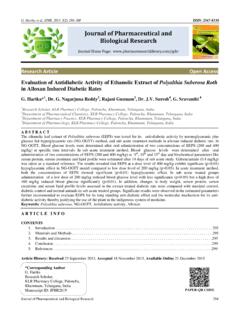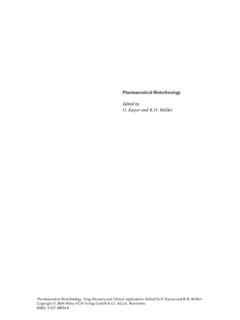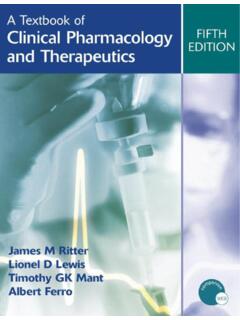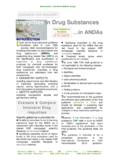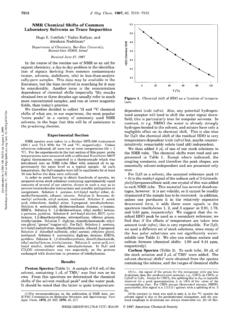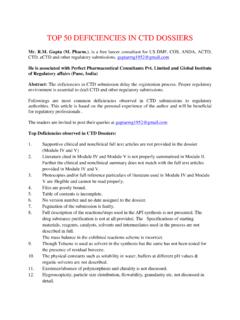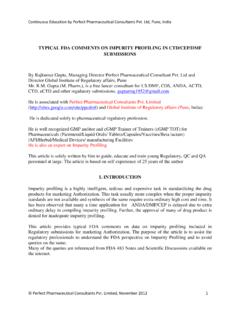Transcription of Research Article Open Access Degradation Impurities in ...
1 Sukumar Nandiet al,IJCPS,2016,4(9):479 482 CODEN (USA): IJCPNH|ISSN: 2321-3132 International Journal of Chemistry and Pharmaceutical Sciences479 International Journal of Chemistry andPharmaceutical SciencesJournal Home ArticleOpenAccessDegradationImpuritiesin Linagliptin Drug ProductNaresh Akkinaa, Bala Narasimha Reddy Gonaa,B. Venkateswara Raob, Paul Douglas Sanasib,Sukumar Nandi*aaDepartment of Chemical Research and Development, Aurobindo Pharma limited., Survey No. 71& 72, Indrakaran Village,Sangareddy Mandal, Medak District-502 329, Telangana, of Engineering Chemistry, College of Engineering, Andhra University, Visakhapatnam-530003, AndhraPradesh, B S T R A C TThree degradationimpurities related to Linagliptin (1) drug product,N-Acetyl Linagliptin (2),N-Aminoacyl Linagliptin (3)andN-Formyl Linagliptin (4) have been synthetically prepared and characterized.
2 These Impurities form due to interaction ofexcipient and active pharmaceutical ingredient (API) during formulation. Formation of above drug product degradationimpurities has been :Linagliptin, excipient, drug product, Degradation , impuritiesA R T I C L EI N F .. and Discussion..482 Article History:Received25 May2016,Accepted19 July2016,Available Online27 September2016 PAPER-QRCODEC itation:Dr. Sukumar Nandi,et Impurities in Linagliptin Drug J. Chem, Pharm, Sci., 2016,4(9) 2016Dr. Sukumar Nandi,et is an open- Access Article distributed under the terms of theCreative CommonsAttribution License, which permits unrestricted use, distribution and reproduction in any medium, provided the original workis IntroductionDegradation products in drug product formulations aresought to be tightly controlled by pharmaceutical upon the drug s maximum daily dose,regulatory guidelines require the characterization andtoxicological evaluation of degradationimpurities.
3 Drugdegradation of products is generated by interaction of many*Corresponding AuthorDr. Sukumar Nandi,Department of Chemical Research andDevelopment, Aurobindo Pharma limited,Survey No. 71 &72, Sangareddy,Medak-502 329, Telangana, ID: IJCPS3101 Sukumar Nandiet al,IJCPS,2016,4(9):479 482 CODEN (USA): IJCPNH|ISSN: 2321-3132 International Journal of Chemistry and Pharmaceutical Sciences479 International Journal of Chemistry andPharmaceutical SciencesJournal Home ArticleOpenAccessDegradationImpuritiesin Linagliptin Drug ProductNaresh Akkinaa, Bala Narasimha Reddy Gonaa,B. Venkateswara Raob, Paul Douglas Sanasib,Sukumar Nandi*aaDepartment of Chemical Research and Development, Aurobindo Pharma limited., Survey No. 71& 72, Indrakaran Village,Sangareddy Mandal, Medak District-502 329, Telangana, of Engineering Chemistry, College of Engineering, Andhra University, Visakhapatnam-530003, AndhraPradesh, B S T R A C TThree degradationimpurities related to Linagliptin (1) drug product,N-Acetyl Linagliptin (2),N-Aminoacyl Linagliptin (3)andN-Formyl Linagliptin (4) have been synthetically prepared and characterized.
4 These Impurities form due to interaction ofexcipient and active pharmaceutical ingredient (API) during formulation. Formation of above drug product degradationimpurities has been :Linagliptin, excipient, drug product, Degradation , impuritiesA R T I C L EI N F .. and Discussion..482 Article History:Received25 May2016,Accepted19 July2016,Available Online27 September2016 PAPER-QRCODEC itation:Dr. Sukumar Nandi,et Impurities in Linagliptin Drug J. Chem, Pharm, Sci., 2016,4(9) 2016Dr. Sukumar Nandi,et is an open- Access Article distributed under the terms of theCreative CommonsAttribution License, which permits unrestricted use, distribution and reproduction in any medium, provided the original workis IntroductionDegradation products in drug product formulations aresought to be tightly controlled by pharmaceutical upon the drug s maximum daily dose,regulatory guidelines require the characterization andtoxicological evaluation of degradationimpurities.
5 Drugdegradation of products is generated by interaction of many*Corresponding AuthorDr. Sukumar Nandi,Department of Chemical Research andDevelopment, Aurobindo Pharma limited,Survey No. 71 &72, Sangareddy,Medak-502 329, Telangana, ID: IJCPS3101 Sukumar Nandiet al,IJCPS,2016,4(9):479 482 CODEN (USA): IJCPNH|ISSN: 2321-3132 International Journal of Chemistry and Pharmaceutical Sciences479 International Journal of Chemistry andPharmaceutical SciencesJournal Home ArticleOpenAccessDegradationImpuritiesin Linagliptin Drug ProductNaresh Akkinaa, Bala Narasimha Reddy Gonaa,B. Venkateswara Raob, Paul Douglas Sanasib,Sukumar Nandi*aaDepartment of Chemical Research and Development, Aurobindo Pharma limited., Survey No. 71& 72, Indrakaran Village,Sangareddy Mandal, Medak District-502 329, Telangana, of Engineering Chemistry, College of Engineering, Andhra University, Visakhapatnam-530003, AndhraPradesh, B S T R A C TThree degradationimpurities related to Linagliptin (1) drug product,N-Acetyl Linagliptin (2),N-Aminoacyl Linagliptin (3)andN-Formyl Linagliptin (4) have been synthetically prepared and characterized.
6 These Impurities form due to interaction ofexcipient and active pharmaceutical ingredient (API) during formulation. Formation of above drug product degradationimpurities has been :Linagliptin, excipient, drug product, Degradation , impuritiesA R T I C L EI N F .. and Discussion..482 Article History:Received25 May2016,Accepted19 July2016,Available Online27 September2016 PAPER-QRCODEC itation:Dr. Sukumar Nandi,et Impurities in Linagliptin Drug J. Chem, Pharm, Sci., 2016,4(9) 2016Dr. Sukumar Nandi,et is an open- Access Article distributed under the terms of theCreative CommonsAttribution License, which permits unrestricted use, distribution and reproduction in any medium, provided the original workis IntroductionDegradation products in drug product formulations aresought to be tightly controlled by pharmaceutical upon the drug s maximum daily dose,regulatory guidelines require the characterization andtoxicological evaluation of degradationimpurities.
7 Drugdegradation of products is generated by interaction of many*Corresponding AuthorDr. Sukumar Nandi,Department of Chemical Research andDevelopment, Aurobindo Pharma limited,Survey No. 71 &72, Sangareddy,Medak-502 329, Telangana, ID: IJCPS3101 Sukumar Nandiet al,IJCPS,2016,4(9):479 482 CODEN (USA): IJCPNH|ISSN: 2321-3132 International Journal of Chemistry and Pharmaceutical Sciences480excipient and active pharmaceutical ingredients (API) [1-2].Many of the API s involves hydrolysis, oxidation orspecific interaction of drugs with reactive Impurities inexcipient [3-5]. Understanding the excipient (reactiveimpurity sources) and its impact on the drug productstability is essential in designing and developing a robustdrug product [6-7]. As a part of ongoing Research onLinagliptin (1) drug product formulation,we envisagedformation of three Degradation Impurities , namelyN-AcetylLinagliptin (2),N-Aminoacyl Linagliptin (3) andN-FormylLinagliptin (4).
8 2. ExperimentalReagentsAcetyl chloride, triethyl amine, acetic anhydride, Formicacid and urea were used as raw materials. Linagliptin usedfor the preparation of Impurities was prepared as per theliterature reported method. Dichloromethane, hexanes andethanol were used as solvents to carry out the reaction andfor crystallization of the product. All the above solventswere purified by the reported procedures [8].InstrumentationMelting points are measured in Polmon MP96 capillarymelting point apparatus and are uncorrected. The1H NMRspectra was recorded in Varian 500 MHz FT NMRspectrometer in DMSO-d6. The chemical shifts werereported in ppm relative to TMS ( ppm) as internalstandard. IR spectra were recorded on a Perkin-Elmer FT-IR instrument (KBrpellet method). Mass spectra wererecorded using a 4000-Q-trap LC-MS/MS massspectrometer.
9 The solvents and reagents were used withoutfurther purification. Chromatographic purity of impuritieswas analyzed qualitatively by procedure (Material Synthesis)Preparation of (R)-N-[1-[7-(But-2-yn-1-yl)-3-methyl-1-[ (4-methylquinazolin-2-yl)methyl]-2,6-dio xo-2,3,6,7-tetrahydro-1H-purin-8-yl]pipe ridine-3-yl]acetamide[N-Acetyl Linagliptin](2):Linagliptin (2 g, mole) wasdissolved in methylene chloride (20 ml) at 20-30 C. It wascooled to 0-5 C and triethylamine ( g, mol) wasadded slowly over a period of 15 min. To the above stirredsolution, acetyl chloride ( g, mol) was addedslowly over a period of 10 min at 0-5 C. The reaction masswas stirred at 0-5 C for 1 h and quenched by adding ice-cold water (20 ml). Temperature was raised to roomtemperature. The organic layer was separated and washedwith aqueous sodium chloride solution (20 ml, ~10% w/w).
10 The washed methylene chloride layer was concentrated at40-45 C to obtain the concentrated mass was crystallized from hexanes andfiltered. It was dried at 40-45 C under reduced pressure of~20 mm Hg. Yield: pale yellow powder (Hexanes); : 208-209 C; IR (KBr): 3690, 2831, 2410, 2126, 1550,1265 cm-1;1H NMR (500 MHz,CDCl3): (ppm); (m, 4H), (s, 3H), (s, 3H), (s, 3H), (m, 4H), (s, 3H), (m, 1H), & (ABq, 2H), (s, 2H), (d, 1H), (dd, 1H), (dd, 1H), (d, 1H), (d, 1H); Mass (PE SCIEX-API 2000) ESIin +ve ion mode: m/z; 515 [M+H]+.Preparation of (R)-N-[1-[7-(But-2-yn-1-yl)-3-methyl-1-[ (4-methylquinazolin-2-yl) methyl]-2, 6-dioxo-2, 3, 6, 7-tetrahydro-1H-purin-8-yl] piperidine-3-yl] urea[N-Aminoacyl Linagliptin] (3):Linagliptin (10g, ) was suspended in DM water (200 ml). Urea ( g, mol) was added along with tetrabutylammoniumbromide ( g, catalytic) and the reaction mixture washeated to 90-100 C.

